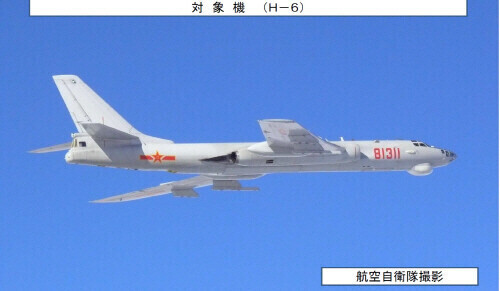hankyoreh
Links to other country sites 다른 나라 사이트 링크
Chinese, Russian warplanes enter KADIZ without notice

Two Chinese bombers and four Russian fighters and bombers flew through South Korea’s air defense identification zone (KADIZ) east of Dokdo on Tuesday, South Korea’s Joint Chiefs of Staff said. Coming on the heels of US President Joe Biden’s attempt to tighten the screws on China and Russia during a tour of Korea and Japan from Friday to Tuesday, the two countries may have intended the maneuver as a show of force.
The Joint Chiefs of Staff said that two Chinese H-6 bombers entered the KADIZ 126 km northwest of a submerged rock called Ieodo at 7:56 am on Tuesday and traveled to the East Sea before exiting to the north at 9:33 am.
After that, the Chinese aircraft joined up with four Russian warplanes (two TU-95 bombers and two fighters) in the northern part of the East Sea and reentered the KADIZ in that region at 9:58 am. The group of fighters finally exited the KADIZ east of Dokdo at 10:15 am, the Joint Chiefs said.
The Joint Chiefs said that six more warplanes (four from China and two from Russia) were again detected outside the KADIZ, 267 km southeast of Ieodo, at 3:40 pm. This group of warplanes flew north along the edge of the KADIZ for 17 minutes, at which point the Chinese warplanes veered off while the Russian warplanes continued north.
“There were no incursions into [Korea’s] territorial airspace on this day. The air force took the tactical measure of scrambling fighters to prepare for any contingencies before [the foreign warplanes] entered the KADIZ,” the Joint Chiefs said.
An air defense identification zone is conceptually distinct from territorial airspace. It denotes an area a country has delineated outside its airspace in order to identify foreign aircraft before they enter its airspace. Air forces set up such zones because they may not have enough time to respond to foreign warplanes once they’ve already entered territorial airspace.
Korea’s military authorities regard the flight through the KADIZ as part of a joint exercise between China and Russia.
After Korea warned China that its aircraft had entered the KADIZ, Chinese officials explained over their hotline that the flight was part of a normal drill. The Russians didn’t offer any such notice, a source in the military said.
China and Russia’s decision to send warplanes into the KADIZ without prior notification may have been a show of force designed to respond to Biden’s attempt to counter and pressure them during his tour of Korea and Japan.
The warplanes’ flight received pushback from Japanese Defense Minister Nobuo Kishi, who said, “China and Russia have ratcheted up the level of provocation by deliberately holding this demonstrative military exercise during the Quad summit.”
By Kwon Hyuk-chul, staff reporter; Kim So-youn, Tokyo correspondent
Please direct questions or comments to [english@hani.co.kr]

Editorial・opinion
![[Column] Life on our Trisolaris [Column] Life on our Trisolaris](https://flexible.img.hani.co.kr/flexible/normal/500/300/imgdb/original/2024/0505/4817148682278544.jpg) [Column] Life on our Trisolaris
[Column] Life on our Trisolaris![[Editorial] Penalties for airing allegations against Korea’s first lady endanger free press [Editorial] Penalties for airing allegations against Korea’s first lady endanger free press](https://flexible.img.hani.co.kr/flexible/normal/500/300/imgdb/original/2024/0502/1817146398095106.jpg) [Editorial] Penalties for airing allegations against Korea’s first lady endanger free press
[Editorial] Penalties for airing allegations against Korea’s first lady endanger free press- [Editorial] Yoon must halt procurement of SM-3 interceptor missiles
- [Guest essay] Maybe Korea’s rapid population decline is an opportunity, not a crisis
- [Column] Can Yoon steer diplomacy with Russia, China back on track?
- [Column] Season 2 of special prosecutor probe may be coming to Korea soon
- [Column] Park Geun-hye déjà vu in Yoon Suk-yeol
- [Editorial] New weight of N. Korea’s nuclear threats makes dialogue all the more urgent
- [Guest essay] The real reason Korea’s new right wants to dub Rhee a founding father
- [Column] ‘Choson’: Is it time we start referring to N. Korea in its own terms?
Most viewed articles
- 1New sex-ed guidelines forbid teaching about homosexuality
- 2OECD upgrades Korea’s growth forecast from 2.2% to 2.6%
- 3[Column] Life on our Trisolaris
- 460% of young Koreans see no need to have kids after marriage
- 5Months and months of overdue wages are pushing migrant workers in Korea into debt
- 6[Guest essay] Maybe Korea’s rapid population decline is an opportunity, not a crisis
- 7Presidential office warns of veto in response to opposition passing special counsel probe act
- 8Is Japan about to snatch control of Line messenger from Korea’s Naver?
- 9Bills for Itaewon crush inquiry, special counsel probe into Marine’s death pass National Assembly
- 10Hybe-Ador dispute shines light on pervasive issues behind K-pop’s tidy facade